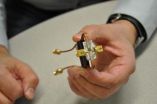(Press-News.org) RIVERSIDE, Calif. (http://www.ucr.edu) — A team of researchers from the University of California, Riverside Bourns College of Engineering and Russian Academy of Science have demonstrated a new type of holographic memory device that could provide unprecedented data storage capacity and data processing capabilities in electronic devices.
The new type of memory device uses spin waves – a collective oscillation of spins in magnetic materials – instead of the optical beams. Spin waves are advantageous because spin wave devices are compatible with the conventional electronic devices and may operate at a much shorter wavelength than optical devices, allowing for smaller electronic devices that have greater storage capacity.
Experimental results obtained by the team show it is feasible to apply holographic techniques developed in optics to magnetic structures to create a magnonic holographic memory device. The research combines the advantages of the magnetic data storage with the wave-based information transfer.
"The results open a new field of research, which may have tremendous impact on the development of new logic and memory devices," said Alexander Khitun, the lead researcher, who is a research professor at UC Riverside.
A paper, "Magnonic Holographic Memory," that describes the finding has been submitted for publication in the journal Applied Physics Letters. An advance copy of the paper can be accessed at: http://arxiv.org/abs/1401.5133
There are three co-authors of the paper: Frederick Gertz, a graduate student who works with Khitun at UC Riverside, and A. Kozhevnikov and Y. Filimonov, both of the Russian Academy of Sciences.
Holography is a technique based on the wave nature of light which allows the use of wave interference between the object beam and the coherent background. It is commonly associated with images being made from light, such as on driver's licenses or paper currency. However, this is only a narrow field of holography.
The first holograms were designed in the last 1940s for use with electron microscopes. A decade later, with the advent of the laser, optical holographic images were popularized. Since, other fields have significantly advanced by using wave interference to produce holograms, including acoustic holograms used in seismic applications and microwave holography used in radar systems.
Holography has been also recognized as a future data storing technology with unprecedented data storage capacity and ability to write and read a large number of data in a highly parallel manner.
Khitun has been working for more than nine years to develop logic device exploiting spin waves. Most of his initial research was focused on the development of spin wave-based logic circuits similar to the ones currently used in the computers.
A critical moment occurred last year when he decided the device didn't need to replace the computer's electronic circuits. Instead, the device would complement the circuits, or help them accomplish certain tasks, such as image recognition, speech recognition and data processing.
The experiments outlined in the paper were conducted using a 2-bit magnonic holographic memory prototype device. A pair of magnets, which represent the memory elements, were aligned in different positions on the magnetic waveguides.
Spin waves propagating through the waveguides are affected by the magnetic field produced by the magnets. When spin waves interference was applied in the experiments, a clear picture was produced and the researchers could recognize the magnetic states of the magnets. All experiments were done at room temperature.
INFORMATION:
The research was supported in part by: The Center for Function Accelerated nanoMaterial Engineering (FAME), which is funded with $35 million from the Semiconductor Research Corporation (SRC), a consortium of semiconductor industry companies; the Defense Advanced Research Projects Agency; and the National Science Foundation under the NEB2020 Grant ECCS-1124714.
Using holograms to improve electronic devices
Researchers have demonstrated a holographic memory device that could improve storage capacity and processing capabilities in electronics
2014-02-19
ELSE PRESS RELEASES FROM THIS DATE:
Statistics research could build consensus around climate predictions
2014-02-19
Philadelphia, PA—Vast amounts of data related to climate change are being compiled by research groups all over the world. Data from these many and various sources results in different climate projections; hence, the need arises to combine information across data sets to arrive at a consensus regarding future climate estimates.
In a paper published last December in the SIAM Journal on Uncertainty Quantification, authors Matthew Heaton, Tamara Greasby, and Stephan Sain propose a statistical hierarchical Bayesian model that consolidates climate change information ...
Smellizing -- imagining a product's smell -- increases consumer desire, study finds
2014-02-19
Seeing is believing, but smellizing – a new term for prompting consumers to imagine the smell of a product – could be the next step toward more effective advertising.
Researchers came to this conclusion through four studies of products most of us would like to smellize: cookies and cake.
Professor of Marketing Maureen Morrin of Temple University's Fox School of Business co-authored Smellizing Cookies and Salivating: A Focus on Olfactory Imagery to examine the impact imagining what a food smells like would have on consumer behavior.
"Before we started this project, ...
Discovery by Baylor University researchers sheds new light on the habitat of early apes
2014-02-19
WACO, Texas (Feb. 18, 2014)-- Baylor University researchers, in collaboration with an international team of scientists, have discovered definitive evidence of the environment inhabited by the early ape Proconsul on Rusinga Island, Kenya. The groundbreaking discovery provides additional information that will help scientists understand and interpret the connection between habitat preferences and the early diversification of the ape-human lineage.
Their research findings--published this month in Nature Communications--demonstrate that Proconsul and its primate relative Dendropithecus ...
Graduate student makes major discovery about seal evolution
2014-02-19
Ottawa, February, 19, 2014—In the world of science, one of the most exciting things a researcher can do is pin down an answer to a widely asked question. This experience came early for Carleton University graduate Thomas Cullen, who made a discovery about pinnipeds—the suborder that makes up seals, sea lions and walruses—while doing research for his Master's degree under the supervision of Canadian Museum of Nature palaeontologist Dr. Natalia Rybczynski.
His discovery, published the journal Evolution, relates to sexual dimorphism (a large variance in size between males ...
Huntington's disease: Hot on the trail of misfolded proteins' toxic modus operandi
2014-02-19
WASHINGTON D.C. Feb. 19, 2014 -- Proteins are the workhorses of the cell, and their correctly folded three-dimensional structures are critical to cellular functions. Misfolded structures often fail to properly perform these vital jobs, leading to cellular stress and devastating neurodegenerative disorders such as Alzheimer's, Parkinson's and Huntington's disease.
In comparison with the mysteries of Alzheimer's or Parkinson's disease, Huntington's disease has a seemingly simple culprit: an expansion in the polyglutamine (polyQ) tract of a protein called "Huntingtin" (Htt). ...
Rutgers scientists identify structure of virus that could lead to hepatitis C vaccine
2014-02-19
Rutgers University scientists have determined the structure of a hepatitis C surface protein, a finding that could assist in the development of a vaccine to halt the spread of the the deadly disease that has infected 3.2 million Americans.
Joseph Marcotrigiano, associate professor of chemistry and chemical biology, says this new research – published online today in Nature – describes an outer region of hepatitis C that enables the virus to evade the body's natural immune system response, causing persistent, chronic infection.
Hepatitis C is constantly mutating, allowing ...
The ups and downs of early atmospheric oxygen
2014-02-19
RIVERSIDE, Calif. — A team of biogeochemists at the University of California, Riverside, give us a nontraditional way of thinking about the earliest accumulation of oxygen in the atmosphere, arguably the most important biological event in Earth history.
A general consensus asserts that appreciable oxygen first accumulated in Earth's atmosphere around 2.3 billion years ago during the so-called Great Oxidation Event (GOE). However, a new picture is emerging: Oxygen production by photosynthetic cyanobacteria may have initiated as early as 3 billion years ago, with oxygen ...
NuSTAR telescope takes first peek into core of supernova
2014-02-19
Astronomers for the first time have peered into the heart of an exploding star in the final minutes of its existence.
The feat is one of the primary goals of NASA's NuSTAR mission, launched in June 2012 to measure high-energy X-ray emissions from exploding stars, or supernovae, and black holes, including the massive black hole at the center of our Milky Way Galaxy.
The NuSTAR team reported in this week's issue of the journal Nature the first map of titanium thrown out from the core of a star that exploded in 1671. That explosion produced the beautiful supernova remnant ...
Managed honeybees linked to new diseases in wild bees
2014-02-19
Diseases that are common in managed honeybee colonies are now widespread in the UK's wild bumblebees, according to research published in Nature. The study suggests that some diseases are being driven into wild bumblebee populations from managed honeybees.
Dr Matthias Fürst and Professor Mark Brown from Royal Holloway University of London (who worked in collaboration with Dr Dino McMahon and Professor Robert Paxton at Queen's University Belfast, and Professor Juliet Osborne working at Rothamsted Research and the University of Exeter) say the research provides vital information ...
Gene sequencing project discovers common driver of a childhood brain tumor
2014-02-19
(MEMPHIS, Tenn. – February 19, 2014) The St. Jude Children's Research Hospital-Washington University Pediatric Cancer Genome Project has identified the most common genetic alteration ever reported in the brain tumor ependymoma and evidence that the alteration drives tumor development. The research appears February 19 as an advanced online publication in the scientific journal Nature.
The results provide a foundation for new research to improve diagnosis and treatment of ependymoma, the third most common brain tumor in children. St. Jude has begun work to translate the ...
LAST 30 PRESS RELEASES:
Mount Sinai Health system receives $8.5 million NIH grant renewal to advance research on long-term outcomes in children with congenital heart disease
Researchers develop treatment for advanced prostate cancer that could eliminate severe side effects
Keck Medicine of USC names Christian Pass chief financial officer
Inflatable fabric robotic arm picks apples
MD Anderson and SOPHiA GENETICS announce strategic collaboration to accelerate AI-driven precision oncology
Oil residues can travel over 5,000 miles on ocean debris, study finds
Korea University researchers discover that cholesterol-lowering drug can overcome chemotherapy resistance in triple-negative breast cancer
Ushikuvirus: A newly discovered giant virus may offer clues to the origin of life
Boosting the cell’s own cleanup
Movement matters: Light activity led to better survival in diabetes, heart, kidney disease
Method developed to identify best treatment combinations for glioblastoma based on unique cellular targets
Self-guided behavioral app helps children with epilepsy sleep earlier
Higher consumption of food preservatives is associated with an increased risk of type 2 diabetes
NTU Singapore-led team captures first-ever ‘twitch’ of the eye’s night-vision cells as they detect light, paving the way for earlier detection of blindness-causing diseases
Global aviation emissions could be halved through maximising efficiency gains, new study shows
Fewer layovers, better-connected airports, more firm growth
Exposure to natural light improves metabolic health
As we age, immune cells protect the spinal cord
New expert guidance urges caution before surgery for patients with treatment-resistant constipation
Solar hydrogen can now be produced efficiently without the scarce metal platinum
Sleeping in on weekends may help boost teens’ mental health
Study: Teens use cellphones for an hour a day at school
After more than two years of war, Palestinian children are hungry, denied education and “like the living dead”
The untold story of life with Prader-Willi syndrome - according to the siblings who live it
How the parasite that ‘gave up sex’ found more hosts – and why its victory won’t last
When is it time to jump? The boiling frog problem of AI use in physics education
Twitter data reveals partisan divide in understanding why pollen season's getting worse
AI is quick but risky for updating old software
Revolutionizing biosecurity: new multi-omics framework to transform invasive species management
From ancient herb to modern medicine: new review unveils the multi-targeted healing potential of Borago officinalis
[Press-News.org] Using holograms to improve electronic devicesResearchers have demonstrated a holographic memory device that could improve storage capacity and processing capabilities in electronics










